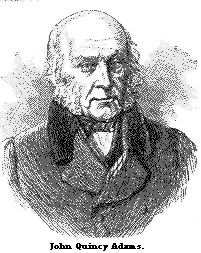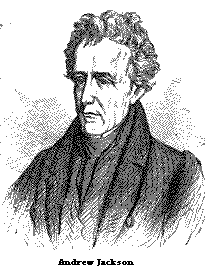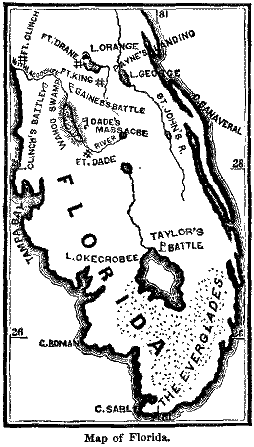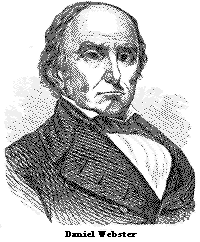Resource Center OLLibrary
|
192 |
|
6. In 1819 a
convention with Great Britain was ratified, securing to
citizens of the United States, with some restriction, the right of
fishing on the coast of British America, and establishing parallel
49o north as the boundary between the United
States and British America, from the Lake of the Woods to the
Rocky Mountains. The same year Spain agreed to relinquish
Florida1 to the United States, on the condition
that the American government should ![]() pay
to citizens of the United States five millions of dollars, due
them from Spain, and give up all claim to the present State of
Texas.
pay
to citizens of the United States five millions of dollars, due
them from Spain, and give up all claim to the present State of
Texas.
Two years later, Spain ratified the treaty, and
at the same time the boundary between the Louisiana
Purchase2 and the Spanish province of Mexico was
defined.
7. The president, in his annual
message to Congress, December, 1823, alluding to the Spanish
colonies of America, recently recognized as sovereign powers,
declared that "the American continents, by the free and
independent position which they have assumed and maintain, are
henceforth not to be considered as subjects for future
colonization by any European powers." He also declared that it is
impossible for the powers of Europe to "extend their political
system to any portion of either continent without endangering our
peace and happiness," and that "it is equally impossible,
therefore, that we should behold such interposition, in any form,
with indifference." This has since been known as the Monroe
doctrine, the authorship of which, however, belonged to the
secretary of state, John Quincy Adams.
8. In August, 1824,
Lafayette came to the United States as the guest of the
nation whose independence he had assisted in gaining with his
blood and his fortune. He visited each of the twenty-four states,
and was everywhere received with enthusiastic greetings of
gratitude and joy. He remained in the country a little more than a
year, and when ready to return, the president3 placed
at his disposal a frigate, named, in compliment to him,
Brandywine,4 to carry him back to France. Congress
manifested still further their appreciation of his services by
voting him a township of land and two hundred thousand
dollars.
9. When the time came to choose a
successor to Mr. Monroe, four candidates were in the field,
neither of whom received a majority of the electoral vote. The
choice then
1 See p. 206, ¶ 13, and note 1. 2 See p. 166 ¶
3. John Quincy Adams, who had succeeded to the presidency during Lafayette's visit.
4 See p. 125, ¶ 14.
QUESTIONS. -- 6. What convention was ratified with England in 1819? What was secured and what established by this convention? When did Florida come into the possession of the United States? On what condition? What boundary was defined at the same time? 7. What is the Monroe doctrine? 8. What can you tell of Lafayette's visit to the United States? 9. At the next presidential election how many candidates were in the field?
|
|
193 |
devolved on the House of
Representatives,1 and that body elected John Quincy
Adams, of Massachusetts, president. John Caldwell
Calhoun,2 of South Carolina, was chosen vice
president by the electors.
The candidates were General Jackson, then a
United States senator, Mr. Adams, secretary of state, William H.
Crawford, secretary of the treasury, and Henry Clay, the speaker
of the House of Representatives.3
CHAPTER VI.
JOHN QUINCY ADAMS'S ADMINISTRATION.4 1825-1829.
 1.
EARLY in this administration the question
of the supremacy of the nation over the state -- a question that
frequently meets us during this period5 -- was again
forced upon the people, by a controversy with Georgia concerning
the Creek lands.
1.
EARLY in this administration the question
of the supremacy of the nation over the state -- a question that
frequently meets us during this period5 -- was again
forced upon the people, by a controversy with Georgia concerning
the Creek lands.
In pursuance of a treaty, obtained, without the
consent of the Creeks, from a few of their chiefs, Georgia
determined to remove these Indians by force from the lands they
occupied, and in 1827 declared her intention to resist the
authority of the United States, Which had been interposed, by the
president, to protect the Creeks. The difficulty was, however,
adjusted for the time, the Indians consenting to remove beyond the
Mississippi, in consideration of a large annuity to be paid them
from the national treasury.
2. The
fiftieth anniversary of the national independence, July 4,
1826,![]() was made specially memorable by the deaths of John Adams
and Thomas Jefferson, which occurred on that day. The
coincidences of the lives of these eminent patriots were
strikingly com-
was made specially memorable by the deaths of John Adams
and Thomas Jefferson, which occurred on that day. The
coincidences of the lives of these eminent patriots were
strikingly com-
1 See Appendix, p. 16. Art. XII., Amendments Const. U. S. 2 See p. 171, ¶ 2.
3 They had respectively, ninety-nine, eighty-four, forty-one, and thirty-seven electoral votes.
4 In the House of Representatives, thirteen states voted for Mr. Adams. see Appendix, p. 20.
5 See p. 165, ¶ 5; p. 197, ¶ 8; p. 198, ¶ 9; p. 227, ¶ 10, and p. 232, ¶¶ 5, 6.
QUESTIONS. -- Who was elected president for the next term? Vice-president? What is said of Mr. Adams's election? Chap. VI. 1. What question was forced upon the people early in Adams's administration? By what controversy? -- Give an account of this controversy and its adjustment? 2. For what is the fiftieth anniversary of the national independence memorable?
17
|
194 |
|
pleted in the coincidence of their deaths. Both were early
enlisted in their country's cause. Both were bold, ardent,
unyielding patriots. Where others doubted, they were resolved;
where others hesitated, they pressed forward. They were both
members of the committee to prepare the Declaration of
Independence, and they constituted the sub-committee appointed by
the other members to make the draugbt of it. Jefferson was the
author of the Declaration; Adams its great supporter on the floor
of Congress. Both had been ministers abroad; both vice-presidents,
and both presidents; both had lived to a great
age.1
3. The policy of protecting home
manufactures, by imposing heavy duties upon articles of the same
kind imported, was carried to its height, under the name of the
American system, by ![]() the
tariff of 1828. All assent to the propriety of levying duties for
revenue merely, but the principle of a protective
tariff, nearly ever since the passage of this act, has been a
subject of contention between political parties. Having the most
of its friends in the manufacturing Northern and Middle States,
and the most of its enemies in the agricultural South, it has
proved a fruitful source of sectional strife.
the
tariff of 1828. All assent to the propriety of levying duties for
revenue merely, but the principle of a protective
tariff, nearly ever since the passage of this act, has been a
subject of contention between political parties. Having the most
of its friends in the manufacturing Northern and Middle States,
and the most of its enemies in the agricultural South, it has
proved a fruitful source of sectional strife.
4. This administration, more than
any preceding it, fostered measures of internal improvement. State
and individual enterprise took the same direction. While Mr. Adams
was president the first railroad in the United States was
completed; 2 and New York, chiefly through the
exertions of her distinguished son, De Witt Clinton, opened the
Erie Canal, which became the highway to the grain fields of the
west.
5. The country had never enjoyed
greater prosperity than during the presidency of Mr. Adams. The
national debt was rapidly diminishing, and the national treasury
held a surplus of over five millions of dollars. Yet Mr. Adams
failed of a reëlection. The era of good feeling had passed
away, and party spirit again burst forth with increased
bitterness.
At the next presidential
election, Andrew Jackson, of Tennessee, after a contest of
unexampled violence, was chosen president, and Mr. Calhoun
was reëlected vice-president.
1 Adams was nearly ninety-one, Jefferson nearly eighty-three.
2 The first railroad in the United States was in Quincy, Massachusetts, and was completed in 1827. The first steam locomotive used in the United states was put on the road from Carbondale to Honesdale, Pennsylvania, by the Delaware and Hudson Canal Company, in 1829.
QUESTIONS. -- What coincidences of the lives of Adams and Jefferson can you mention? 3. What is meant by the American system? To what do all assent? What has been the subject of contention between political parties? Why was the protective tariff a source of sectional strife? 4. What is said of internal improvement? 5. Of the country during Mr. Adams's presidency? Of party spirit? -- Who were elected president and vice-president for the next term?
|
|
195 |
CHAPTER VII.
JACKSON'S ADMINISTRATION.1 1829-1837.
 1.
PRESIDENT Jackson, on entering upon the
duties of his high position, removed from
office2 many of those who had opposed his election,
and appointed his political adherents in their stead; thus giving
his administration, at the outset, a more strictly party character
than had been attempted by his predecessors. This has continued to
be the policy of each new administration.
1.
PRESIDENT Jackson, on entering upon the
duties of his high position, removed from
office2 many of those who had opposed his election,
and appointed his political adherents in their stead; thus giving
his administration, at the outset, a more strictly party character
than had been attempted by his predecessors. This has continued to
be the policy of each new administration.
2. In his domestic policy, Jackson
was opposed to devoting the public revenue to internal
improvements, and in several instances interposed his
veto3 to arrest congressional appropriations for that
purpose, believing them to be unconstitutional and inexpedient.
His foreign policy was bold and vigorous.
The payment of indemnities for
spoliation of American commerce4 was secured,
and, except from France, without difficulty. This nation had
acknowledged the justice of the American claim to five millions of
dollars, but refused to make appropriation for payment. At this,
the president proposed that reprisals should be made upon French
property till the American claim was liquidated. Affairs seemed
threatening, when both nations agreed to accept the proffered
mediation of Great Britain. Meanwhile, France appropriated the
money, and the claim was paid.
3. The subject of Indian
removals5 had not ceased to disturb the country.
First a difficulty arose between Georgia
1 see Appendix, p. 20.
2 During he first year of this administration, there were nearly seven hundred removals from office not including subordinate clerks. During the forty years preceding, there had been sixty-four.
3 see Appendix, p. 10, Sec. VII., Art. I., Const. U. S.
4 By Denmark, Naples, Portugal, Spain, and France. 5 See p. 193, 11.
QUESTIONS. -- 1. How did Jackson, at the outset, give his administration a party character? 2. What is said of Jackson's domestic policy? Of his foreign policy? -- What trouble arose with France? What did the president propose? How was the trouble settled? 3. What is said of Indian removals? What difficulty first arose?
|
196 |
|
and the Cherokees1 within her
borders, which was not finally adjusted till the next
administration.
 These
Indians had made considerable advance in civilization. Contrary to
law, as interpreted by the Supreme Court,2 Georgia
attempted to drive them from their lands. The president and
Congress sided with the state. The agent sent to aid in the
removal of the Indians was General Scott who, by his conciliatory
policy, induced them to migrate peaceably.
These
Indians had made considerable advance in civilization. Contrary to
law, as interpreted by the Supreme Court,2 Georgia
attempted to drive them from their lands. The president and
Congress sided with the state. The agent sent to aid in the
removal of the Indians was General Scott who, by his conciliatory
policy, induced them to migrate peaceably.
4. In the spring of 1832, a war, known as
the Black Hawk war, broke out on the north-![]() western
frontier, with some tribes led by the celebrated Black Hawk, a
chief of the Sacs.3 This war resulted in the removal of
the Indians farther westward.
western
frontier, with some tribes led by the celebrated Black Hawk, a
chief of the Sacs.3 This war resulted in the removal of
the Indians farther westward.
A campaign against them, by Unite States
troops and Illinois militia,4 under Generals Scott and
Atkinson, gained for the United States a large portion of the
present Iowa and Wisconsin, and drove the Indians beyond the
Mississippi. Black Hawk was taken prisoner.
5. Near the close of 1835 arose war
with the Seminoles,5 under the famous warrior
![]() Osceola
-- a war more formidable than any in which the United States had
ever engaged with the Indians. It was seven years be fore the
savages were subdued.6
Osceola
-- a war more formidable than any in which the United States had
ever engaged with the Indians. It was seven years be fore the
savages were subdued.6
The cause of the war was ax
attempt to remove the Seminoles, in Florida, to lands, west of the
Mississippi in accordance with a treaty, the validity of which the
Indians denied. The war extended its ravages into Georgia and
Alabama. Many of the Creeks joined the Seminoles. From their
skulking places in the swamps and the Everglades, where poisonous
vapors and venomous reptiles defended them from pursuit, they
would dash upon the settlements to rob, murder, and
destroy.
1 See p. 23, note (See. V.). 2 See Appendix, p. 13. Secs. I., II., Art. Ill., Const. U. S.
3 See p 22 note (See 11., 12).
4 In this war Abraham Lincoln was captain of a company of Illinois volunteers, Jefferson Davis a lieutenant in the United States regulars. See p 227, ¶¶ 9., 11.
5 See p 22, note (See. IV., 2). 6 In 1842, during Tyler's administration.
QUESTIONS. -- Give an account of this difficulty and its settlement? 4. What war broke out in 1832 and where? Result? -- What farther is said of this war? 5. What war arose in 1835? Under what famous warrior? What is said of this war? -- Cause of the war? Where did its ravages extend?
|
|
197 |
6. At the
opening of the war (December 28), Major Dade and more than a
hundred men were waylaid near the Wahoo Swamp, and all but
four killed. On the same day, the United States agent, General
Thompson, and five others, in view of the garrison at Fort
King, were set upon, slain, and scalped, by Osceola and a
party of Indians. Osceola thus satiated his revenge for an
imprisonment he had suffered at the hands of the agent. Soon
after, General Clinch marched from Fort Drane against the
Indians, and, after defeating them, returned to the fort. The next
February, General Gaines came to his assistance, and another
action took  place,
in which the savages were again worsted, near Clinch's
battle-ground. The following summer, General Scott marched into
the Creek Country, subdued the Indians there, and sent
several thousands of them beyond the Mississippi. The Seminoles
continued the war. In
place,
in which the savages were again worsted, near Clinch's
battle-ground. The following summer, General Scott marched into
the Creek Country, subdued the Indians there, and sent
several thousands of them beyond the Mississippi. The Seminoles
continued the war. In ![]() October,
1837, General Jessup, then in command in Florida, seized the
treacherous Osceola, whom no oath could bind nor treaties
restrain, while approaching the American camp under a flag of
truce, and sent him a prisoner to Fort Moultrie.1 The
capture of their leader, though a severe blow to the Seminoles,
did not end the war. Colonel Taylor2 pursued them into
their almost inaccessible hiding places, and beat them in a
hard-fought battle, December 25, 1837, near Lake Okechobee,
in the southern part of Florida. After this, several able officers
took their turns in pacifying and fighting the Seminoles, before
they were brought to terms.3
October,
1837, General Jessup, then in command in Florida, seized the
treacherous Osceola, whom no oath could bind nor treaties
restrain, while approaching the American camp under a flag of
truce, and sent him a prisoner to Fort Moultrie.1 The
capture of their leader, though a severe blow to the Seminoles,
did not end the war. Colonel Taylor2 pursued them into
their almost inaccessible hiding places, and beat them in a
hard-fought battle, December 25, 1837, near Lake Okechobee,
in the southern part of Florida. After this, several able officers
took their turns in pacifying and fighting the Seminoles, before
they were brought to terms.3
7. In 1832,
that terrible pestilence, the Asiatic cholera, made its
first appearance in America, beginning in Canada, and thence
sweeping over the United States.
8. This administration
was more severely tried than any that had preceded it, by the
dangerous dogma of state rights.
The relative powers of the nation and the state
came up for discussion in Congress during the winter of 1829-30.
Daniel Webster,4 then a
1 See Map, p. 137. 2 See p. 174, note 4, and pp. 208-213.
3 Colonels Taylor and Worth, ad Lieutenants Robert Anderson, J. E. Johnston, and George H. Thomas were among those promoted for gallantry in this war. 4 See p. 181, ¶ 24.
QUESTIONS. -- 6. Give an account of the massacre near Wahoo Swamp. Near Fort King. Of the action near Fort Drane. What was done by General Scott in the summer? What was done by General Jessup in 1837? What by Colonel Taylor? What further is said of the war? What is said of the Asiatic cholera? 8. How was this administration severely tried?
17*
|
|
|
|
|
|
© 1999, 2000, 2001 for NEGenWeb Project by Ted & Carole Miller